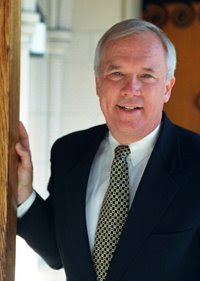
Here’s the full release:
Historical artifacts from First United Methodist
(“First Church”) were revealed on this cold
and wintry day of January 17, 2009, as the cornerstone of
the burned out sanctuary was opened for the first time in
over 119 years.
The cornerstone, located in the last partial remaining wall
of the First Church sanctuary that burned October 6, 2006,
will be taken down soon by controlled demolition to be
reused in the new sanctuary design.
Balancing high upon the scaffolding near the limestone
brick cornerstone that reads, “First M. E.
Church, November 1889,” Senior Pastor Rev. Martha B.
Wagley welcomed the crowd gathered at the church site at 2nd
and Poplar.
Bundled up in scarves, hats and gloves, the First Church
congregation, the First Church Building Committee, Carter
Hord of Hord Architects, designers of the new church campus,
Justin Grinder, of Grinder, Taber and Grinder, the General
Contractors, members of the West Tennessee Historical
Society, and friends of the church, listened and waited
excitedly as Rev. Wagley explained the significance of the
day.
She said, “Almost 120 years ago our ancestors stood
upon this holy ground, lead by Bishop E.R. Hendrix, to
place a cooper box and its contents inside this cornerstone
and dedicate this once magnificent sanctuary after many
years of planning and sacrifice.” She then read from
1st Corinthians 10-11, “According to the grace of God
given to me, as a skilled master builder, I
laid the foundation, and someone else is building on it.
For no one can lay any foundation other than the one that
has been laid; that foundation is Jesus Christ.”
With the help of Bobby Parnell, the mason performing
controlled demolition of this historic landmark, Rev. Wagley
gently removed the 8 x 12 inch cooper box housed inside the
reception cavity of the cornerstone.
To everyone’s delight and relief, the copper box was
intact after nineteen decades and had survived the fire two
years ago.
After prying open the sealed box, Rev. Wagley delicately
retrieved each historical item that their First Church
ancestors had saved on November 19th, 1889, which included:
1. A silver quarter, the first contribution towards the
cost of the sanctuary building, given by Benjamin Abernathy,
church sexton, along with his photograph
2. Photographs of Revs. James W. Knott and Samuel Watson,
former pastors and J.W. Jefferson, a church member
3. A copy of the bible from the American Bible Society
4. A copy of the Methodist Church Discipline
5. Copies of the Methodist Hymn Books
6. A piece of the U.S. flag torn down in New Orleans in
1862
7. A bottle of water from the River Jordan
8. The last Annual Report of the American Bible Society
9. A list of those who contributed to the sanctuary
10. A copper coin
11. Copies of the Appeal and Avalanche (Memphis Newspapers)
12. A copy of the Women’s Advocate
13. A list of the names of the pastor, church members and
the Building Committee
14. A copy of the Nashville Christian Advocate
Concluding this emotional and uplifting morning, the Rev.
J. Barry Henson, McKendree District Superintendent, said a
prayer for this resilient congregation on this historic
occasion connecting the past, the present and the future
First Church, “As we gather here, we are standing on
the shoulders of the saints who came before us, those who
many years ago lead the way. We lean on the shoulders of
those here today who will rebuild the church – not only for
our children, but for those yet unborn, so that they may
worship on this holy ground again.”
First United Methodist is the first church of any
denomination in Memphis, established in 1826.
The new sanctuary will be the 4th First Church house of
worship at the corner of Second and Poplar.
First Church is seeking donations to complete construction
and to realize their dream to continue in mission in
downtown Memphis.
www.firstchurchmemphis.org



